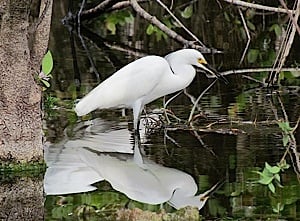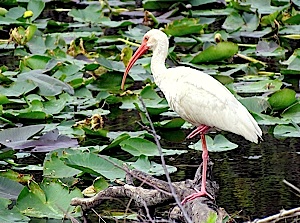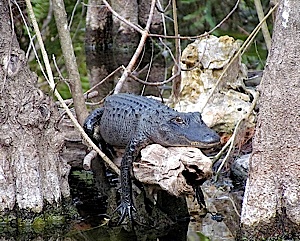Hopefully everyone’s planning a birding excursion to Alaska after reading Kurt’s review of his adventures in Glacier Bay National Park. In the meantime, a less frigid destination might be suitable for most travelers during the impending winter.
There aren’t many locations within the National Park System where bird-watching is easier than in Big Cypress National Preserve. It’s even possible to see a lot of birds (and alligators) while careening down the highway at 55 mph. (We, of course, don’t recommend careening anywhere where an endangered Florida Panther might cross your path.)
The heart of birding in Big Cypress just happens to be US Route 41, also famously known as the Tamiami Trail. Head from Naples to Miami (or vice versa) and you’ll be rewarded with mile after mile of birds right along the side of the road. For much of this trip a canal runs parallel to the highway on the north side, providing ideal habitat for wading birds.
Two of North America’s most exquisite herons, the great egret (Ardea alba) and snowy egret (Egretta thula), are present here in extraordinary numbers. Being tall, starkly white birds, these guys are hard to miss. The great egret is a three-foot tall wader with black legs and feet. The snowy egret is smaller, but is most identifiable by its “golden slippers” – bright yellow feet at the bottom of black legs.

Snowy Egrets are common in Big Cypress. Photo by Kirby Adams.
It’s hard not to smile at this bird’s fashion statement as you watch one patiently fishing from a perch above shallow water. Traffic can be somewhat heavy and fast-moving on the Tamiami Trail, but if you can find a safe spot to pull aside, the egrets are relatively tolerant of slow-moving humans, provided there’s water between them and you.
This same stretch of highway also provides a unique habitat for the belted kingfisher (Ceryle alcyon). As their name implies, kingfishers love to fish, so the shallow water in ditches and canals near the highway is perfect habitat. The other habitat feature provided by the highway is the kingfisher’s favorite perch: power lines.
Birders often joke that they don’t know what kingfishers perched on before there were power lines. I’ve driven for stretches of several miles on US 41 seeing only a handful of sections of power line that weren’t occupied by a kingfisher. This is a great example of wildlife adapting very well to human artifacts and even turning these “unnatural” features to their advantage.
Unlike the egrets, kingfishers are very wary and not easily approached. Get too close to one, and it will take off, landing on a branch (or wire!) a little farther away and letting out a loud rattling warning call. Sooner or later, you’ll want to get out of the car and take a closer look at the surroundings.
Four areas warrant some extra scrutiny, though it’s a safe bet you’ll spot fascinating wildlife no matter where you pull off this highway.
Moving west to east, your first stop is appropriately the Big Cypress Swamp Welcome Center that acts as an interagency visitor center for all public lands in the swamp. Short trails and viewing areas right behind the center offer a good chance to see manatees and, depending on the time of year, a plethora of songbirds in the mangrove trees lining the water.
We spotted a Wilson’s Warbler (Cardellina pusilla) cavorting through the mangroves here, and I proved that birders are a unique breed by chasing the little guy with my camera while most of the tourists nearby were understandably enthralled by three manatees that were surfacing and putting on a show.

White ibis are another white-feathered bird you can easily spot. Kirby Adams photo.
A few miles down the road is a spot near and dear to my heart. I have a rather unique first name, so I was pleased to discover Kirby Storter Roadside Park. I have not been able to find out who Kirby Storter is or was, but this is a beautiful park dedicated to him (her?) by the state of Florida in 1970, but still wholly within Big Cypress National Preserve. A short trail here leads to a boardwalk through a cypress swamp with wonderful views of wading birds, woodpeckers, warblers, and even raptors. You’ll spot 20 species here without even trying.
For bird diversity, this trail rivals the famous trails of Everglades National Park to the south. Kirby Storter is interestingly also thought to be the darkest spot on the mainland of south Florida, something amateur astronomers greatly appreciate.
About half way from Naples to Miami you’ll find the Oasis Visitor Center. The Tamiami Canal runs between the visitor center and the highway. From a walkway in front of the center you can watch alligators basking and get a close view of wading birds catching fish.
For the new birder, there is often a ranger or two milling about the walkway eager to answer any questions about the wildlife. We had the pleasure of watching an anhinga catch a huge catfish, defend it from a great blue heron that tried to pilfer the catch, then painfully swallow the oversized fish. The fish’s spines bloodied the anhinga and I was convinced he wouldn’t be able to swallow it, but the ranger had seen this act before and knew better, telling me he was sure the meal would get to the bird’s stomach.
It took every second of ten minutes, but eventually the anhinga swallowed the fish to polite applause from all of us in the gallery.
The last stop is technically not even in Big Cypress, but rather just east of the border with the Miccosukee Indian Reservation. There’s an abandoned air-boat concession platform north of the highway, just west of the Miccosukee village. From here, you can look out over a vast swampy meadow of grass and, if you’re lucky, see a snail kite.
The snail kite (Rostrhamus socialbilis) is a federally endangered bird with a uniquely specialized diet. It eats only one thing: apple snails. This raptor’s bill is specially designed to pluck the juicy innards of a snail from within its shell.

While they're not birds, alligators also are fairly easy to spot in the preserve Kirby Adams photo.
Spotting the kites is a matter of watching for a raptor hovering above pools of water or picking one out as it soars far overhead with the vultures and other raptors.
Snail kites are numerous in Central and South America, but their numbers have been declining in Florida, the only area of North America where they can be found. Fluctuating and declining water levels in swamps throughout Florida have impacted the apple snail population, thus limiting the food supply for the kites.
Some reports have surfaced of snail kites catching crayfish when desperate, but it’s clear the bird’s continued existence in Florida is tied directly to the snails and hence to the health of the wetlands. Those are just four of many highlights along this treasured highway. Ideally a couple days should be allowed to catch all the sights.
For those wishing to make the Tamiami Trail a multi-day birding adventure, a bungalow can be rented near the halfway point right in the middle of the swamp. I spent several evenings here watching warblers, woodpeckers, and gnat-catchers through the large windows of the living room.
With the ease of access to all this wonderful bird viewing, it’d be a crime for a birder to miss the Tamiami Trail when anywhere near south Florida!


 Support Essential Coverage of Essential Places
Support Essential Coverage of Essential Places







Comments
Kirby did a fine article here but skipped describing where Old Florida/Gladesman spots are that truly reflect local culture of the region.
The NPS welcome center mentioned is nice but so tame. For some real Gladesman Cultural style excitement there is Wooten's Air Boat Rides a privately owned operation 1/2 mile West of the welcome center.
Then if folks get hungry there is Joanies Crab Cafe 2 miles East of the welcome center. This is a great place to stop and refresh ones self and enjoy the art work and all of Joanie's artifacts hanging from the walls and ceiling. Joanie is the black haired lady there with a gravely voice. Not surprisingly her daughter owns and operates the Camelia Street Cafe; a very popular eatery in nearby Everglades City.
Then for those who enjoy camping their is an alternative to NPS's campgrounds at Trail Lakes Campground (TLC) located 3 miles East of the same welcome center. This is also the location of the Skunkape Research Center reported on frequently in different media outlets. Now one may be able to camp at NPS's facilities cheaper or for free but one needs to understand local businneses need to be supported in this area especially TLC since they are having to compete with NPS's many campgrounds in Big Cypress providing in excess of 51,000 camping stay days annually at way below market costs which is next to impossible to compete with. The real problem is that NPS doesn't have to break even. One thing for sure Trail Lakes Campground is much more economical that the bungaloes mentioned and has security on duty 7-24-365.
One thing not debatable is that Big Cypress is a really cool place and very very vast.